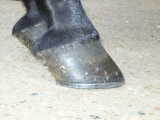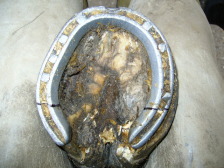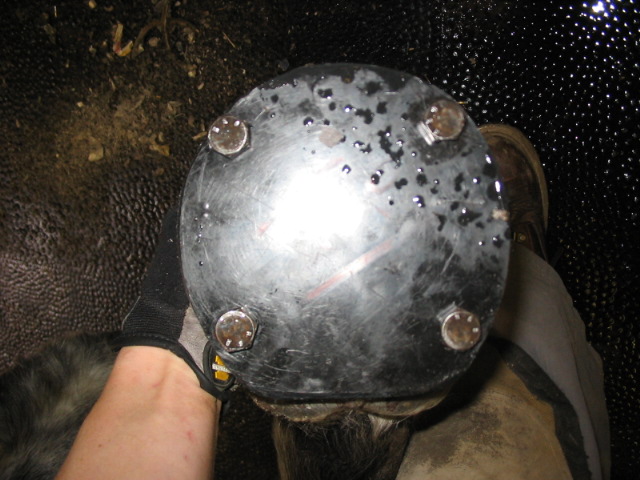Beckie’s Equine Letter
News and Case Studies
Summer 2006 — Issue 11
News for the Month
Hope you’re all having a great summer. I’m certainly enjoying all of these lovely long sunny days, I very quickly forget that we even have a winter in England :-) Now that I’m only doing these Newsletters four times a year I have even more News to share with you all. So I will start with the most significant of the lot...
In May I was fortunate enough to be invited to a hands-on Advanced Lameness Clinic in Colorado Springs. It was run by Gene Ovnicek, the man behind all of the Natural Balance principles. There were just 12 of us on the course, 4 Brits and the other 8 had flown in from various places around the States. What made it even more unique is that 3 of the 12 were female! The course was run by the Equine Lameness Prevention Organisation (ELPO) to which I have now qualified to be a member.
The purpose of the course was to become certified in various aspects of advanced farriery. There are three main levels which consist of practical and written exams.
• Certified Barefoot Trimmer
• Certified Advanced Natural Balance Farrier
• Certified Lameness Specialist
I can proudly say I am now one of only 12 Farrier’s in the World to be certified to this level of barefoot trimming and Natural Balance Shoeing. I am making plans to maybe return to Colorado next year to do my Lameness Specialist Exam.
All of my exams have to be updated every two years so this really is a progressive organisation I now belong to. It really was a fantastic experience with great like minded people. It was a tough week, we were all really pushed, but I have come back with a much better understanding and appreciation of the what is possible as far as preventing and assisting with lameness’s. In the Lesson of the month I will show you some examples of the cases we dealt with. Also my Case Study will give you an idea of the use of Clogs one of the most recent tools for maintaining soundness.
Moving on... at the beginning of May I was involved in Anvil Vets open evening. This was an evening of talks by their three Vets: Alistair, Nicky and Richard. The resident Physio and Dentist also gave demonstrations. I was involved in a trimming demonstration as well as answering peoples questions on farriery. It was a great evening with a turnout of over 100 people.
I’m also involved in a Farrier’s and Vets open day in July, where the four of us that went to Colorado are sharing the new things we have learnt and doing demonstrations. So lots to look forward to in the coming months. Hope you enjoy this newsletter and I look forward to seeing you all again soon.
Lesson of the Month
Some of the interesting things I got to see in America
 This horse was one of the most horrific cases I’ve seen. She had broken her left knee and due to the scar tissue that had developed there was very limited flexion of the whole leg. She has also foundered (the pedal bone had dropped through the sole) on the right front due to the extra weight load. It took a real team effort to deal with her as she needed a lot of holding up. We could only trim the foot on the broken leg as she could barely bend it. Then we put a support system on the right front to help prevent the pedal bone sinking any further. I found it very cruel that this horse had been kept alive as I don’t think it would have been if it lived in the UK.
This horse was one of the most horrific cases I’ve seen. She had broken her left knee and due to the scar tissue that had developed there was very limited flexion of the whole leg. She has also foundered (the pedal bone had dropped through the sole) on the right front due to the extra weight load. It took a real team effort to deal with her as she needed a lot of holding up. We could only trim the foot on the broken leg as she could barely bend it. Then we put a support system on the right front to help prevent the pedal bone sinking any further. I found it very cruel that this horse had been kept alive as I don’t think it would have been if it lived in the UK.
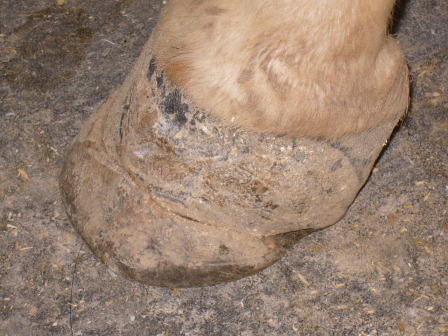
This picture above isn’t quite so clear, but hopefully you can see a crack just over half way down the wall that runs all the way around. This is caused by Selenium Poisoning. High selenium levels in the soil are absorbed by the plants that the horses eat, which can cause selenium toxicity to develop. A crack forms half way down the hoof wall and the wall begins to detach from the pedal bone. In time the wall will often fall off completely.

This picture above is a contraption we made up that can be taken on or off. The horse had severely damaged his flexor tendon’s to the extent he can’t put his foot anywhere near flat to the floor without this boot on. This was very much a case of lateral thinking about how we could get the horse comfortable. Using ply wood can be very versatile, as you can easily keep shaving off bits to get the angles of the leg right.
This picture below is showing a horse that has Laminitis. You can see the separation and haemorrhage of the white line clearly by the half moon shape damage at the front. If you could see this in colour the whole of the bottom of the toe is bright red and oozing yellow serum. This is a much more standard case that I would deal with regularly here. We supported the bottom of the foot with a pad, with impression material in the back part of the foot to encourage him to land on the area that isn’t sore. This horse walked way pretty sound after the shoeing.
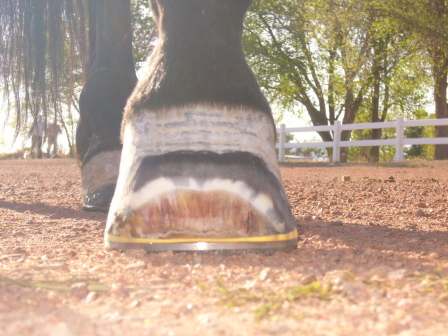
Case Study
Clogs
Clogs are one of the most recent tools we have for solving some lameness’s. Here I have got some pictures showing two different ways of applying Clogs. You can either screw and glue them on, or nail them on as you would a normal shoe.
Clogs offer complete stability to the hoof capsule, working in a similar way to a cast. They prevent the hoof from expanding due to the 360 degree support. They prevent upward force from the ground, and due to the rounded edges on all the sides it relieves the stress on the hoof when turning. The front edge
of the clog is beveled off so it can be positioned under the tip of the pedal bone. This removes any separating effect caused to the wall and pedal bone from having a long toe.
The main problems a clog is used for are: Laminitis/Founder, Collateral Ligament damage, and Navicular.
I have already had the chance to use a pair on a horse in England since I’ve been back, and the horse moved better than he had in two years. A good tool.
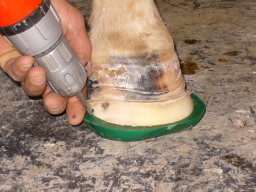

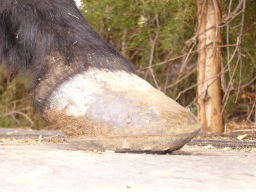
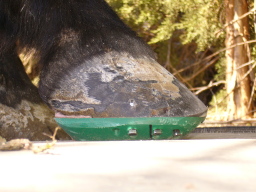
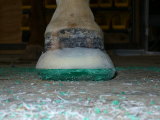


Feedback
Here is some feedback from a very happy customer of mine.
“When we first bought Pip I must admit, we all remarked on his shoeing. It looked ‘different’ so when we had him shod by our previous farrier and ‘normal traditional’ shoes were fitted I felt quite pleased and never gave it a second thought. He was a real one for tripping, and was very unwilling to canter. He had a real lack of confidence in going forward but I never gave it a thought that this would be related to shoeing. People tend, including myself, to put these sort of things down to a physical or mental condition. So he had regular Physiotherapy sessions and Equissage almost every day. But his way of going didn’t really ever improve. I feel a bit foolish now that I left the way he was shod down to the very last elimination!
“The minute you started to shoe Pip I could see you were putting the same type of shoes on, and shoeing him in the same way that he was shod when we first bought him (in Natural Balance shoes). It’s obvious now that his previous farrier had fitted Natural Balance shoes for a reason! When you showed me the difference in the way these shoes will support him, enable him to move so much easier and above all make him more comfortable I felt so relieved. The difference was apparent even while you were shoeing him he seemed to stand more comfortably and relaxed. That evening we just exercised him lightly to allow him to get used to his new shoes, the difference was instant. He didn't trip once, was much more balanced and his upward transitions much smoother. Also when he walked back from the school on hard ground he was really confident, whereas before he would be hesitant, obviously because the poor thing had been worried about falling over!
“I am so happy with what you have done for Pip. No one knows better than me what its like to dance the night away in ill fitting shoes, so I can imagine that’s what its been like for Pip.”
Here are a couple of before and after pictures of Pips feet.
